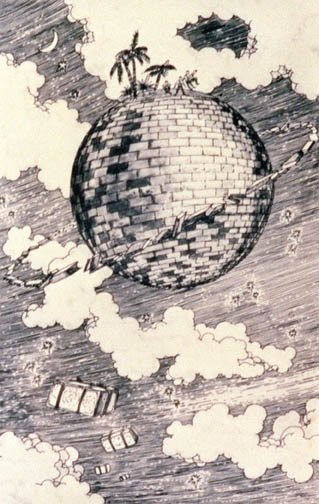JF Ptak Science Books Post 1795
In 1869 Edward Everett Hale (author of "A Man WIthout a Country" in 1863 and also one of the earliest pieces of fiction regarding alternative worlds in"Hands Off" in 1883) wrote a piece of speculative fiction called "The Brick Moon", a story told int he form of a journal of Capt. Frank Ingham, relating the story of the launching of a satellite that was to be an aid to navigation. The construction was fantastic--a sphere made of concentric rings of brick enclosed by an outer layer of brick, reaching 200 feet in diameter, to be hurled into space by two gigantic flywheels on a polar orbit 4,000 miles high, providing a new bright shining star as a means of determining longitude.
"Any section through any diameter looked like an immense rose-window, of six circles grouped round a seventh. In truth, each of these sections would reveal the existence of seven chambers in the moon,—each a sphere itself,—whose arches gave solidity to the whole; while yet, of the whole moon, the greater part was air. In all there were thirteen of these moonlets, if I am so to call them; though no one section, of course, would reveal so many. Sustained on each side by their groined arches, the surface of the whole moon was built over them and under them,—simply two domes connected at the bases. The chambers themselves were made lighter by leaving large, round windows or open circles in the parts of their vaults farthest from their points of contact, so that each of them looked not unlike the outer sphere of a Japanese ivory nest of concentric balls. You see the object was to make a moon, which, when left to its own gravity, should be fitly supported or braced within. Dear George was sure that, by this constant repetition of arches, we should with the least weight unite the greatest strength. I believe it still, and experience has proved that there is strength enough." [Full story here.]

[Image source: here, from the Encyclopedia of Science website.]
Getting the enormous and fantastically heavy "moon" not only off the ground but into space would be an enormous and fantastic mystery--solved here by Hale by the thing being "left to its own gravity" and the two giant flywheels.
It was in this story, published in serial form in the Atlantic Monthly, that the idea of the artificial satellite was introduced. Actually, it was also more than that, because a foul-up caused an early launch of the sphere, launching it into orbit with people on board, making it the first space station. And it was certainy the first collection of space bricks. Of course this took an enormous leap of imagination and insight, and Hale's effort must be applauded as a visionary work.



Comments